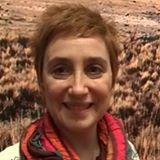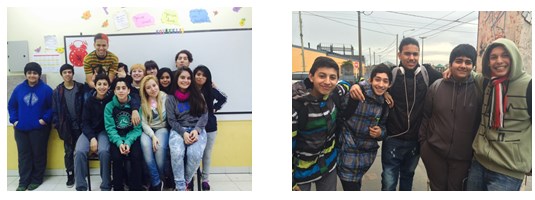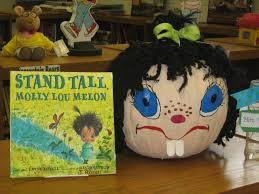Literature to Expand Possibilities of Developing Abstraction
Eugenia Carrión Cantón is a graduated EFL teacher and holds a Licenciatura in English Literature from Facultad de Lenguas UNC and she is currently attending MA in Education at UNQ University of Quilmes. She has been teaching in the field of EFL, literature an Cultural Studies at different levels extensively.Presently she is the vice-chancellor of Teacher Education College IPES “Paulo Freire” in Río Grande city and a curriculum developer for secondary and Teacher Education for the Tierra del Fuego Ministry of Education. Email: eugeniacarrioncanton@gmail.com

Inclusion of ASD learners
The 2014 3rd ESO English class at Dr Laureano Maradona Public Secondary School atten
ds three periods of forty minutes of A1-A2 English lesson every week. The group was made up of fifteen 14-year old students and two of them suffer from Autistic Spectrum Disorders.
Valdez (2015:33) defines ASD as a developmental disorder and states that every educator who attempts to grasp ASD should do it from an evolutionary perspective. In like manner, Alberta Learning Program for Students with Special Needs (2003:p.9) characterise people with Autistic Spectrum Disorders as having language and communication difficulties including delay or lack of expressive language, repetitive speech, restrictive vocabulary, tendency to insist on a topic, inappropriate facial expressions, unusual gestures, lack of eye contact and difficulties with the pragmatic of the conversation.

Being excluded from the possibilities of acquiring mainstream levels of abstraction in language learning due to this developmental disorder, my ASD students presented a limited scenario for the teaching and learning processes. Therefore, teaching English through literature allowed me to adapt to that limited situation and to maximize their possibilities of acquiring knowledge.
In this case I worked with the story Stand Tall Molly Lou Melon by Patty Lovell.
All the activities were thought considering the scaffolding in object-picture-word in the abstraction process of ASD students. The unit was called “people” and the aims were:
- to recognise and use vocabulary related to physical appearance,
- to recognise and use vocabulary related to personality,
- to identify parts of a story,
- to recognise specific vocabulary from the story,
- to reflect upon the importance of being unique and accepting others differences.
Before reading the story I provided post-it blocks for students to label and to stick on their partners all the body parts they knew. So we could concentrate in new vocabulary.
After that I showed a picture of the Molly Lou Melon, the main character of the story and asked them to describe her. She was very short, enormous eyes, with short, black curly hair and dark complexion. I wrote the title of the story on the board and asked the students to make some predictions and I recorded them on the board. ASD students were very concrete in their answers.

Then I started telling the story with digital visual support. While telling the story, I stopped and had students make questions and text-self connections in English and in Spanish. There were only eight new items of vocabulary to concentrate on: four related to physical appearance and four expressions about personality. They were: short, buck teeth, squeaky voice, fumble finger, shrimpo, buck tooth beaver, sound like a sick duck and make the something all wrong. I introduced each of them with flashcards and vocabulary cards so that they were able to connect each object with each word.
As after-reading activities, students retold the story collaboratively in an oral form and then individually in a written one. For this activity they divided a sheet of paper in four sections and wrote first, next, then and last in each section. They had to draw a picture and write one sentence of what happened in each part of the story.
After that and in order to make text-self connections and to reflect upon the importance of being unique and accepting others differences, each student drew a Venn diagram where they wrote Molly Lou Melon on one side and his/ her name on the other. Students had to write the way in which the two were alike in the middle, and the way the two were different in the circles by using the vocabulary about physical appearance and personality they knew and they had just learned.
Then, they shared their productions by reading them aloud and reflected upon the importance of accepting others by answering these questions :
What was different about Molly Lou Melon?
How did Molly Lou’s grandma make her feel special?
Why did Ronald Durkin feel foolish?
How did Ronald Durkin change?
Have you ever felt like Molly Lou Melon?
These reflections were done in English and in Spanish. Last, students listened and read the poem Millions of People by Jane W. Krows as a follow up of the class.
Literature and English teaching entail inclusive practices when through some specific activities like the ones described above, students are able to use the foreign language to communicate with others, to develop coherent ideas relating the text and themselves and to make text-self reflections as well as to echo on values. Pedagogically speaking, ASD students are included to the rest of this public school class when through Literature and English teaching, in this case, they are able to achieve their highest possible level of abstraction like the rest of the students.
Creativity
“You can't use up creativity. The more you use, the more you have.”
Eugenia Carrión Cantón is a graduated EFL teacher and holds a Licenciatura in English Literature from Facultad de Lenguas UNC and she is currently attending MA in Education at UNQ University of Quilmes. She has been teaching in the field of EFL, literature an Cultural Studies at different levels extensively.Presently she is the vice-chancellor of Teacher Education College IPES “Paulo Freire” in Río Grande city and a curriculum developer for secondary and Teacher Education for the Tierra del Fuego Ministry of Education. Email: eugeniacarrioncanton@gmail.com
Inclusion of ASD learners
The 2014 3rd ESO English class at Dr Laureano Maradona Public Secondary School attends three periods of forty minutes of A1-A2 English lesson every week. The group was made up of fifteen 14-year old students and two of them suffer from Autistic Spectrum Disorders.
Valdez (2015:33) defines ASD as a developmental disorder and states that every educator who attempts to grasp ASD should do it from an evolutionary perspective. In like manner, Alberta Learning Program for Students with Special Needs (2003:p.9) characterise people with Autistic Spectrum Disorders as having language and communication difficulties including delay or lack of expressive language, repetitive speech, restrictive vocabulary, tendency to insist on a topic, inappropriate facial expressions, unusual gestures, lack of eye contact and difficulties with the pragmatic of the conversation.
Being excluded from the possibilities of acquiring mainstream levels of abstraction in language learning due to this developmental disorder, my ASD students presented a limited scenario for the teaching and learning processes. Therefore, teaching English through literature allowed me to adapt to that limited situation and to maximize their possibilities of acquiring knowledge.
In this case I worked with the story Stand Tall Molly Lou Melon by Patty Lovell.
All the activities were thought considering the scaffolding in object-picture-word in the abstraction process of ASD students. The unit was called “people” and the aims were:
- to recognise and use vocabulary related to physical appearance,
- to recognise and use vocabulary related to personality,
- to identify parts of a story,
- to recognise specific vocabulary from the story,
- to reflect upon the importance of being unique and accepting others differences.
Before reading the story I provided post-it blocks for students to label and to stick on their partners all the body parts they knew. So we could concentrate in new vocabulary.
After that I showed a picture of the Molly Lou Melon, the main character of the story and asked them to describe her. She was very short, enormous eyes, with short, black curly hair and dark complexion. I wrote the title of the story on the board and asked the students to make some predictions and I recorded them on the board. ASD students were very concrete in their answers.
Then I started telling the story with digital visual support. While telling the story, I stopped and had students make questions and text-self connections in English and in Spanish. There were only eight new items of vocabulary to concentrate on: four related to physical appearance and four expressions about personality. They were: short, buck teeth, squeaky voice, fumble finger, shrimpo, buck tooth beaver, sound like a sick duck and make the something all wrong. I introduced each of them with flashcards and vocabulary cards so that they were able to connect each object with each word.
As after-reading activities, students retold the story collaboratively in an oral form and then individually in a written one. For this activity they divided a sheet of paper in four sections and wrote first, next, then and last in each section. They had to draw a picture and write one sentence of what happened in each part of the story.
After that and in order to make text-self connections and to reflect upon the importance of being unique and accepting others differences, each student drew a Venn diagram where they wrote Molly Lou Melon on one side and his/ her name on the other. Students had to write the way in which the two were alike in the middle, and the way the two were different in the circles by using the vocabulary about physical appearance and personality they knew and they had just learned.
Then, they shared their productions by reading them aloud and reflected upon the importance of accepting others by answering these questions :
What was different about Molly Lou Melon?
How did Molly Lou’s grandma make her feel special?
Why did Ronald Durkin feel foolish?
How did Ronald Durkin change?
Have you ever felt like Molly Lou Melon?
These reflections were done in English and in Spanish. Last, students listened and read the poem Millions of People by Jane W. Krows as a follow up of the class.
Literature and English teaching entail inclusive practices when through some specific activities like the ones described above, students are able to use the foreign language to communicate with others, to develop coherent ideas relating the text and themselves and to make text-self reflections as well as to echo on values. Pedagogically speaking, ASD students are included to the rest of this public school class when through Literature and English teaching, in this case, they are able to achieve their highest possible level of abstraction like the rest of the students.
Creativity
“You can't use up creativity. The more you use, the more you have.”
Maya Angelou
Creativity and teaching are two ideas that, in my view, go hand in hand. They might be related to teachers using imaginative approaches to make learning more exciting, engaging and effective as well as using forms of teaching that are intended to develop students own creative thinking .
Being creative in teaching include high motivation and expectations, the ability to communicate and listen as well as the ability to interest, engage and inspire students. Hence, creative teaching requires expertise both in particular fields and in the pedagogical and didactic arenas. It is also necessary that teachers handle techniques that stimulate students´ curiosity and raise self esteem and confidence. We should be able to recognize not only when encouragement is needed but also when confidence is threatened, striking a balance between structured learning with opportunities for self-direction and the management of groups while giving attention to individuals.
Undoubtably, creativity in teaching is highly demanding but deeply fulfilling. It can involve more time and planning to generate and develop ideas and to evaluate students’ work. It involves confidence to improvise, to pick up unexpected opportunities for learning, to live with uncertainty and to risk admitting that an idea led nowhere. Creative teachers are always willing to experiment but we recognize the need to learn from experience.
Carolyn Edwards and Kay Springate in their article “The Lion Comes out of the Stone: Helping young Children Achieve their Creative Potential” [Dimensions of Early Childhood] give the following suggestions on encouraging student creativity:
- Give students extended, unhurried time to explore and do their best work. Don’t interfere when students are productively engaged and motivated to complete tasks in which they are fully engaged.
- Create an inviting and exciting classroom environment. Provide students with space to leave unfinished work for later completion and quiet space for contemplation.
- Provide an abundant supply of interesting and useful materials and resources.
- Create a classroom climate where students feel mistakes are acceptable and risks taking is encouraged. Appropriate noise, mess and autonomy are accepted.
I personally believe that teaching transforms the world and by being creative we contribute to that transformation since we are open to learn from others while teaching. Besides, Paulo Freire states that “ whoever teaches learns in the act of teaching, and whoever learns teaches in the act of learning”
More at:
https://www.youtube.com/watch?v=yYdni7pv0c4
ww.thenedshow.com/assets/a4-encourage-others-primary-lesson-plan-stand-tall-mary-lou-melon.pdf
https://www.slideshare.net/wikuca22/pdf-download-stand-tall-molly-lou-melon-unlimited
References
Freire, P (1998) Pedagogy of Freedom ethics, democracy and civic Courage Rowman and Littlefield , Maryland.
Edwards, CP and Springate, KW (1995) The Lion Comes Out of the Stone: Helping Young Children Achieve Their Creative Potential. Dimensions of Early Childhood
Alan Maley A and Nik Peachey N (2015) Creativity in the English
language classroom © British Council 2015 Brand and Design/F004 10 Spring Gardens London SW1A 2BN, UK
Alberta Learning (2003) Teaching Students With Autism Spectrum Disorders. Canada Alberta Learning
Anijovich, R (2014) Gestionar Una Escuela Con Aulas Heterogéneas: Enseñar Y Aprender En La Diversidad. Bs As. Paidos
Arró, R (2004) Bases Conceptuales de la Educación Inclusiva. Avances en Supervisión Educativa Vol. 7 http://www.adide.org/
Britt, N . Gold
Brumfit, C and Carter,R (1987) Literature and Language Teaching. Oxford. Oxford University Press
Collie,J & Slater, S Literature in the Language Classroom: A Resource Book of Ideas and Activities. UK.Cambridge University Press
Corbett,J (2007)An Intercultural Approach In English Teaching.UK.Multicultural Matters
Gilkjani(2012) A Study on the Role of Motivation in Foreign Language Learning and Teaching. International Journal of Modern Education and Computer Science. http://www.mecs-press.org/
Jane, W Millions of People USA Utha State Office of Education. Utha State University
Koziner, N(2011)Enseñar/Aprender Inglés en el Encierro . Apuntes de la Experiencia.Bs As Uba XXII Centro de Lenguas www.novedades.filo.uba.ar/
Lazar,G. (1996) Literature and Language Teaching: A guide for teachers and Trainers.UK Cambridge University Press
Ley de Educación Nacional 26.206www.me.gov.ar/doc_pdf/ley_de_educ_nac.pdf
Lovell, P (2001) Molly Lou Melon. USA
Mackay, R (1987) Poems,Modern English Publications
Marchesi, A y Martin, E.(1998) Calidad de la enseñanza en tiempos de cambio.Madrid. Alianza
My Chemical Romance. Song: S.I.N.G
Perry,K Song:. Fireworks
Scrivener, J (2011) Learning Teaching: The Essential Guide to English Language Teaching. MacMillan
Tomlinson, B (1989) Using Poetry with Mixed Ability Language Groups.ELT Journal 40,1.
Unesco (2003) Overcoming Exclusion through Inclusive Approach in Education. A Challenge and a Vision. Paris
Unesco (2009) Policy Guidelines in Inclusion in Education. France
Valdez,D (2015)Ayudas para Aprender:Trastornos del Desarrollo y Prácticas Inclusivas. Bs As. Paidós.
Please check the 21st Century thinking Skills course at Pilgrims website.
Please check the Creative Methodology for the Classroom course at Pilgrims website.
Please check the Special Needs and Inclusive Learning course at Pilgrims website.
Literature to Expand Possibilities of Developing Abstraction
Eugenia Carrión Cantón, ArgentinaWorking Together on a Project
Paola Diotallevi, ItalyCreativity as the Key to Linguistic Competence and Life Skills
Marlene Rebecca Gumhold, AustriaHow Creative are Your Classes?
Victoria ?erban, Romania